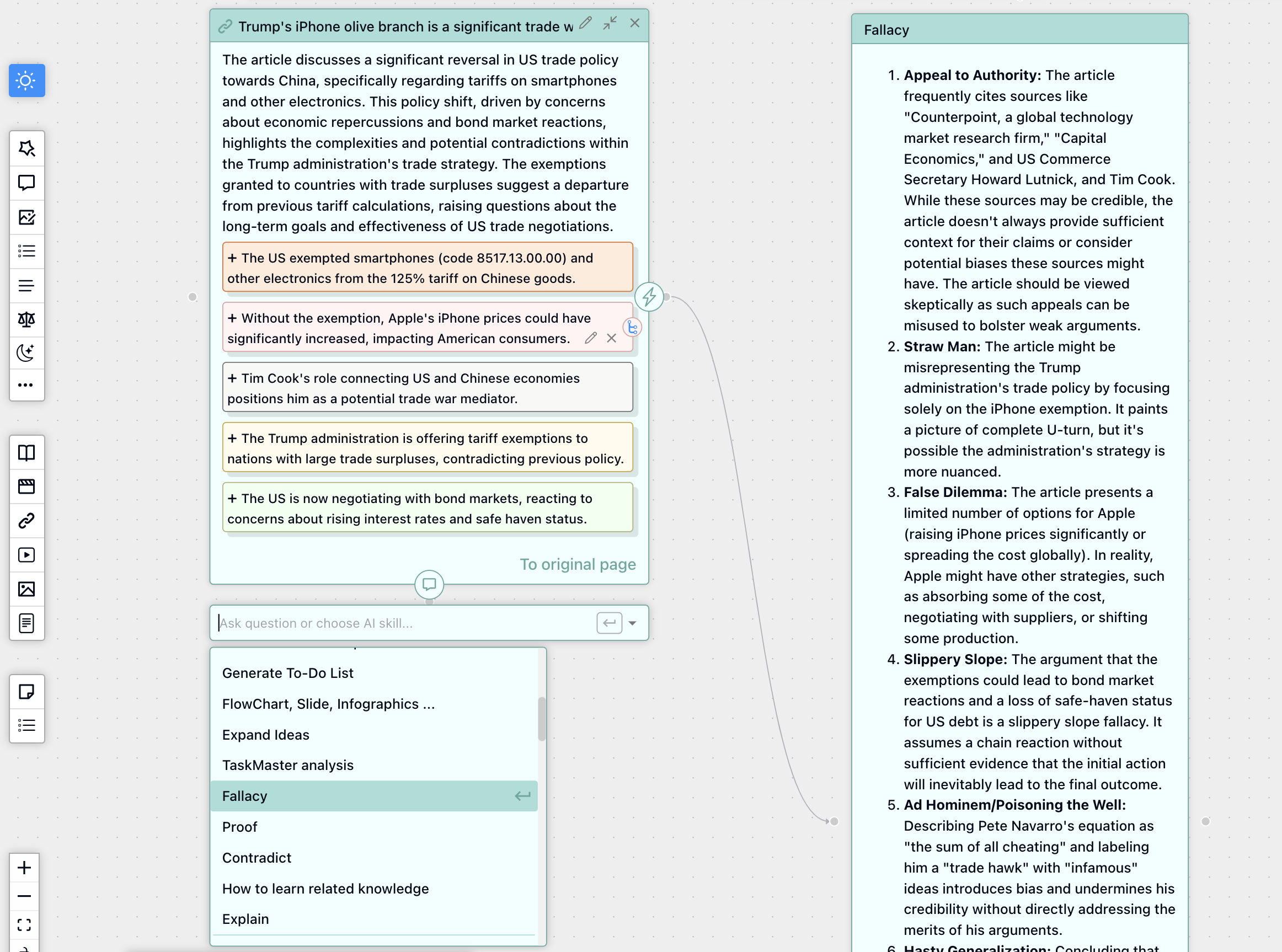Critical Thinking
Analyze Deeply, Decide Wisely
In a world overflowing with information, opinions, and persuasive arguments, critical thinking is no longer a luxury – it's an essential skill for navigating complexity and making sound judgments. This guide explores what critical thinking entails, why it's crucial, and how FunBlocks AIFlow can serve as your digital workbench for dissecting information and structuring your thoughts.
What is Critical Thinking?
Critical thinking is not about being negative or finding fault. It's the intellectually disciplined process of actively and skillfully conceptualizing, applying, analyzing, synthesizing, and/or evaluating information gathered from, or generated by, observation, experience, reflection, reasoning, or communication, as a guide to belief and action.
Essentially, it's about thinking clearly and rationally about what to do or what to believe.
Core Elements (The Standards):
- Clarity: Is the statement or question clear and understandable?
- Accuracy: Is the information true and correct?
- Precision: Is the information detailed and specific enough?
- Relevance: Does the information relate directly to the issue at hand?
- Depth: Does the thinking address the complexities of the issue?
- Breadth: Does it consider other relevant viewpoints or perspectives?
- Logic: Does it make sense? Do the arguments support the conclusion?
- Significance: Is this the most important aspect to consider?
- Fairness: Is the reasoning free from bias and self-interest?
Why is Critical Thinking So Important?
Developing your critical thinking skills offers profound benefits:
- Discern Truth from Falsehood: Identify misinformation, fake news, and biased reporting.
- Make Better Decisions: Evaluate options objectively, weigh pros and cons logically, and anticipate consequences.
- Solve Complex Problems Effectively: Break down problems, analyze root causes, and identify viable solutions.
- Improve Communication & Persuasion: Construct clear, logical arguments and evaluate the arguments of others effectively.
- Foster Intellectual Independence: Form your own well-reasoned opinions rather than passively accepting information.
The Critical Thinking Process & Methods
Critical thinking isn't a single step but a process:
- Identify the Problem/Question/Argument: Clearly define what you are analyzing.
- Gather & Evaluate Information/Evidence: Collect relevant data and assess its credibility, accuracy, and relevance.
- Identify Assumptions & Values: Recognize underlying beliefs (yours and others') that influence the reasoning.
- Analyze Logic & Reasoning: Examine the connections between ideas. Identify logical fallacies (errors in reasoning).
- Consider Alternatives & Perspectives: Explore different viewpoints and potential solutions.
- Formulate Conclusions/Make Judgments: Reach well-supported conclusions based on the evidence and analysis.
Common Frameworks:
- 5W1H: Who, What, When, Where, Why, How – basic questions for understanding a situation.
- SWOT Analysis: Strengths, Weaknesses, Opportunities, Threats – evaluating a plan or position.
- Logic Trees: Breaking down a problem or question into smaller, manageable parts.
- Assumption Testing: Explicitly identifying and challenging underlying assumptions.
Cultivating Critical Thinking Habits
Becoming a better critical thinker is an ongoing practice:
- Stay Curious: Ask "Why?" often. Question assumptions.
- Seek Diverse Perspectives: Actively look for viewpoints that challenge your own.
- Reflect on Your Thinking: Analyze your own biases and reasoning processes.
- Distinguish Fact from Opinion: Learn to separate verifiable information from beliefs or interpretations.
How FunBlocks AIFlow Supports Critical Thinking
FunBlocks AIFlow provides the tools to structure your analysis and visualize complex arguments: Enhancing Critical Thinking Skills with AIFlow
Practice Example: Analyzing News Credibility with AIFlow
Evaluate a news article using AIFlow:
- Setup: Paste the article link or key claims onto the AIFlow board.
- Deconstruct: Generate nodes with AIFlow AI tools for: Key Claims, Evidence Provided, Potential Biases, Alternative Perspectives.
- Analyze: Connect claims to their evidence. Identify any logical fallacies or gaps in reasoning. Highlight potential biases (e.g., loaded language). Map out the main argument structure.

- Conclude: Based on the analysis, form a judgment about the article's overall credibility, supported by the visual evidence on your board.
Summary & Avoiding Thinking Traps
Critical thinking empowers you to engage with the world more effectively. Be mindful of common cognitive biases (like confirmation bias – favoring information that confirms your existing beliefs).
Use FunBlocks AIFlow as your thinking partner to structure your analysis, visualize arguments, and arrive at well-reasoned conclusions. Once you've evaluated ideas, it's time to generate new ones with Creative Thinking.